
Infographic: Email Marketing in 2023 “The Reinvention Formula” With Craig Siegel—How To Discover Your Calling Agile Marketing: A Framework for Delivering Customer Value in a Rapidly Changing Environment 5 Powerful Ways to Make Your Facebook Posts More Engaging Improve Email Marketing Results Using the Six Cs of Content Clarity FREE • ISSUE 46 MotivationandSuccess.com The Rise of Influencer Marketing: How to Partner with the Right Person for Your Brand
Marketing Calendar - pg. 3

The Rise of Influencer Marketing: How to Partner with the Right Person for Your Brand - pg. 4
5 Powerful Ways to Make Your Facebook Posts More Engaging - pg. 9
“The Reinvention Formula” With Craig Siegel—How To Discover Your Calling - pg. 13
Agile Marketing: A Framework for Delivering Customer Value in a Rapidly Changing Environment - pg. 21
Improve Email Marketing Results Using the Six Cs of Content Clarity - pg. 26

Fun Facts- pg. 30
Infographic: Email Marketing in 2023 - pg. 31
MONTH’S ISSUE
INSIDE THIS
Marketing Calendar
Plan your marketing messages around these upcoming holidays and proclamations.
August
Childrens Eye Health & Safety Month Month
Black Business Month
Eye Exam Month
Immunization Awareness Month
Traffic Awareness Month
1st - World Lung Cancer Day
1st - World Wide Web Day
1st - Spider-Man Day
2nd - Ice Cream Sandwich Day
3rd - Watermelon Day
3rd - IPA Day
4th - International Beer Day
4th - Chocolate Chip Cookie Day
5th - Oyster Day
5th - Play Outside Day
6th - Sister’s Day
6th - Friendship Day
8th - International Cat Day
9th - National Book Lovers Day
9th - International Day of Indiginous People
10th - S’mores Day
10th - Spoil Your Dog Day
11th - National Son and Daughter Day
12th - International Youth Day
13th - Filet Mignon Day
14th - Financial Awareness Day
15th - Relaxation Day
16th - Roller Coaster Day
18th - Serendipity Day
18th - World Breast Cancer Research Day
19th - World Photo Day
20th - Radio Day
20th - World Honey Bee Day
21st - Senior Citizen’s Day
24th - Kobe Bryant Day
24th - Waffle Day
26th - Dog Day
26th - Women’s Equality Day
28th - National Bow Tie Day
30th - Beach Day
31st - Eat Outside Day
September
National Service Dog Month
Hispanic Heritage Month
Baby Safety Month
Self Improvement Month
Blood Cancer Awareness Month
National Organic Month
Sucide Prevention Month
Sept 4 - Labor Day (U.S.)
Sept 11 - Patriot Day (U.S.)
Sept 23 - First Day of Fall
2nd - World Beard Day
2nd - Bacon Day
4th - Wildlife Day
5th - Cheese Pizza Day
6th - Read a Book Day
7th - Beer Lovers Day
7th - Google’s Birthday
8th - Physical Therapy Day
10th - World Suicide Prevention Day
10th - Grandparents Day
12th - Video Games Day
13th - International Chocolate Day
13th - Peanut Day
14th - Eat a Hoagie Day
15th - Double Cheeseburger Day
16th - Guacamole Day
16th - Batman Day
17th - Citizenship Day
17th - Dance Day
18th - Equal Pay Day
19th - U.S. Air Force Day
21st - International Day of Peace
21st - World’s Alzheimer’s Day
22nd - Singles Day
25th - Cooking Day
25th - Daughters Day
28th - Good Neighbor Day
28th - Sons Day
29th - World Heart Day
3
The Rise of Influencer Marketing: How to Partner with the Right Person for Your Brand
In today’s digital age, traditional marketing strategies are no longer enough to attract and retain customers. Consumers have become more discerning than ever before, and they demand authenticity and transparency from the brands they support. These days, businesses are using influencer marketing as an effective way to connect with new people and strengthen their brand.

4
By partnering with individuals with a significant following on platforms such as Instagram or TikTok, companies can tap into a ready-made audience and benefit from the trust these influencers have built with their followers. However, as with any marketing strategy, success is far from guaranteed. Choosing the right influencer for your brand, crafting a compelling message, and measuring the effectiveness of your efforts all require careful thought and planning. Let’s explore the key factors that businesses need to consider when embarking on an influencer marketing campaign.
What Is Influencer Marketing?
Influencer marketing is a form of content marketing that uses social media influencers to promote a product or service. These days, with social media being the king of the digital world, many businesses are using influencer marketing as a key component in their marketing plans. The reason for its popularity
is simple: people trust recommendations from those they follow and admire on social media. This is where influencers come in. They have built a loyal following on social media platforms and have a significant impact on their audience’s purchasing decisions.
By partnering with influencers, businesses can tap into their followers’ trust and increase brand awareness. It’s like having a friend recommend a product to you. You’re more likely to trust their opinion and give it a try. As a bonus, influencers often have a deep understanding of their audience’s preferences and interests, allowing businesses to tailor their marketing messages accordingly. So, if you want to take your business to the next level, consider incorporating influencer marketing into your strategy.
Why Influencer Marketing Is an Important Part of Brand Strategy
Influencer marketing is one of the most powerful tools you can use to reach new customers and grow your brand.
Here’s why:
It helps you reach a new audience. Influencers have an audience in their niche that may differ from yours, so collaborating with them gives you access to their followers. This can help generate buzz around your product or service.
It builds trust with potential customers by aligning with trusted voices within their community. If someone sees an influencer recommending something on social media, they’re more likely to check it out themselves because they trust that person’s opinion. Influencers help build both reputation and community, two things every business needs.
Identify the Right Influencers for Your Brand
The first step in identifying the right influencer for your brand is to understand their audience, interests, and motivations. The second step is to evaluate their social media engagement level and network size. To find someone passionate about something, there are a few key things to remember. One of the
5
easiest ways to gauge someone’s enthusiasm is by looking at their social media presence.
Platforms like Twitter and Instagram can indicate how engaged someone is in their chosen field or hobby. Take a moment to see how many followers they have and how often they post. Do they regularly share updates and insights that show they’re actively involved in their community? If so, that’s a great sign.
Another way to gauge someone’s passion is to check how they interact with others. Do they engage in respectful and thoughtful conversations and debates? Do they seem to enjoy talking to others about their interests? If you see evidence of this kind of engagement, it’s a good
indication that they’re truly invested in what they do.
Additionally, look at their comments section. Are other people regularly engaging with their content? If so, that’s another strong indicator that they’re part of a passionate community. Finally, don’t forget to see if they’re seeking new content from other sources. This shows they’re always eager to learn and grow.
Develop a Plan of Action
Once you’ve identified an influencer who might work well with your brand, what steps should you take? Congratulations on identifying an influencer who might work well with your brand. The next step is to act and begin building a relationship with them.

Here are some steps you can take to get started:
• Reach out: Whether through email or social media, contact the influencer and introduce yourself and your brand. Tell them why you think they would be a good fit, and express your interest in working together. Keep your message personalized and friendly.
• Offer value: Influencers are often bombarded with partnership requests, so you need to offer something of value to get their attention. This could be a product sample, exclusive access to content or events, or even payment. Be clear about what you can offer and how it will benefit them.
• Build a relationship: Don’t just think of the influencer as a business transaction. Take the time to build a genuine relationship with them. Engage with their content, share their posts, and show support for their brand. This will help them see that you are a genuine fan, not just someone looking to benefit from their audience.
By following these steps, you’ll be well on your way to building a successful partnership with an influencer who works well with your brand.
Influencers can help your brand grow if you choose the right influencer for your brand. They’re not just another consumer; they’re an advocate and influencer in their own right. They have a following, so it’s important to do what it takes to get them excited about your product or service -- and keep them excited. The right influencer can help you:
• Reach new audiences through their platforms
• Build communities around the things they love (and share)
• Build trust with customers by being transparent about what they’re doing on social media platforms like Instagram or Twitter -- this will encourage more people to follow them.

Influencer marketing has become a powerful tool for brands to reach their target audience and increase their sales. However, it is crucial to partner with the right person who can effectively represent your brand and resonate with your audience.

Following the tips outlined in this post, you can successfully identify and collaborate with influencers who will help your brand grow and expand its reach.
Remember, influencer marketing is not a onesize-fits-all approach, so take the time to research and find the right person who will help your brand achieve its goals.
(800) 277-7398
7

5
Powerful Ways to Make Your Facebook Posts More Engaging

Social media has become a powerful tool for marketing and communication. Facebook is one of the most widely used social media platforms, with over 2.96 billion active monthly users. It offers businesses a unique opportunity to connect with their target audience and drive engagement.
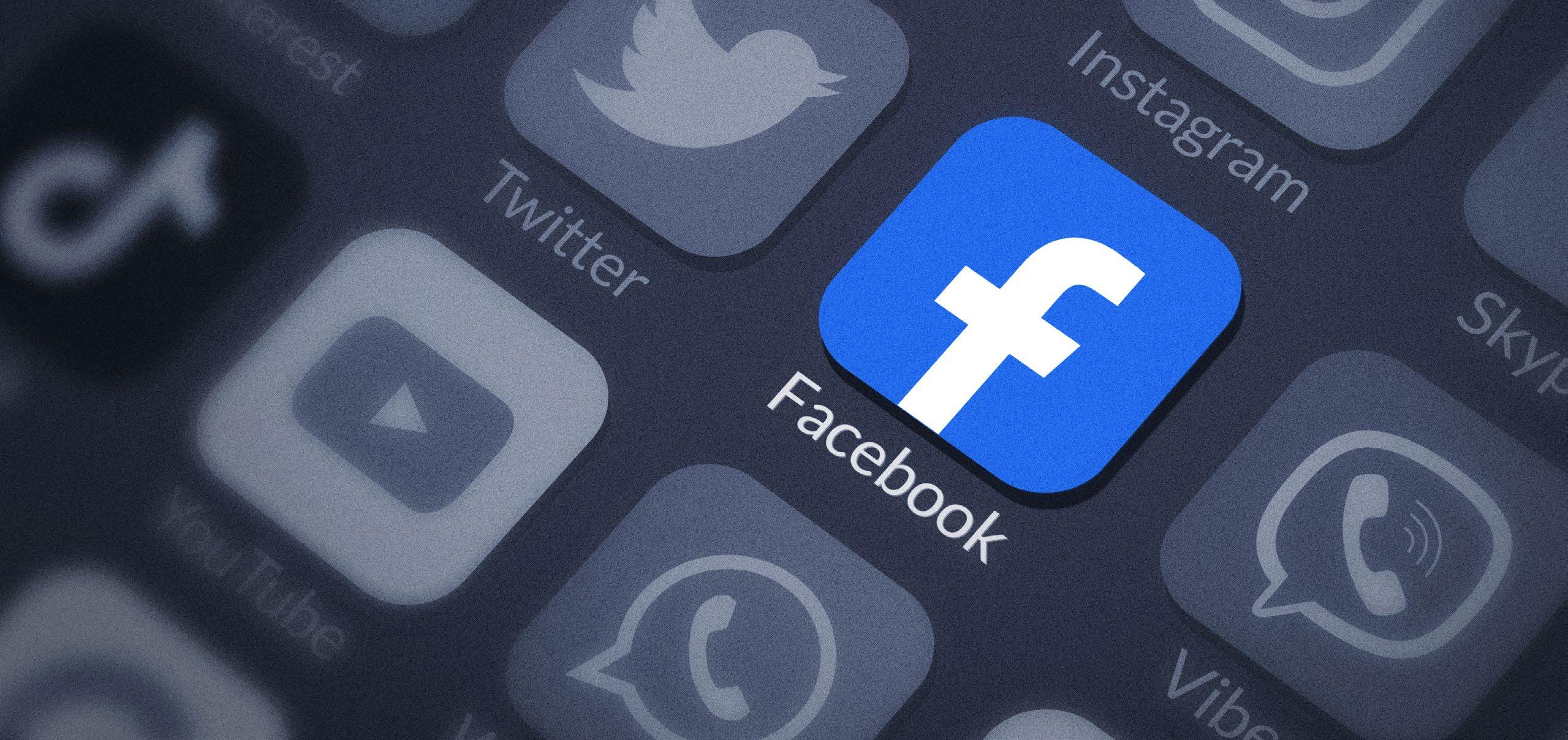
9
However, with so much competition, standing out on Facebook can be challenging. If you’re tired of getting lackluster engagement on your Facebook posts, then this post is for you! Let’s look at ways to make your Facebook posts more engaging.

Use Humor
Humor is an incredibly powerful tool in social media. When you use it correctly, it can create a sense of community and make your audience feel like they’re part of an inside joke - and get a good laugh at the same time! But remember that humor is subjective, and what one person finds funny, another might not. So, it’s essential to strike a balance between being funny and being relatable to your audience.
But don’t be afraid to inject some tasteful humor into your posts! Just make sure it’s appropriate for your audience and aligns with your brand’s tone and voice. And if you’re not naturally funny, don’t worry. There are plenty of other ways to engage your audience, such as sharing interesting articles, asking thought-provoking
questions, or just being authentic and transparent in your posts. The key is to stay true to yourself and your brand, and your audience will appreciate it.
Tell a Story
If you want to connect with your audience, tell a story. A good story will show the human side of your business and highlight the benefits of your product or service. It can also serve as an educational tool by giving information about your brand and how it relates to others in its industry.
Here are
some examples:
Tell a personal anecdote that relates to what you’re posting (e.g., “I remember when my dad took me hiking for the first time...”). This helps establish yourself as part of the community and builds trust with followers by showing them something about yourself that isn’t strictly related to work - it makes them feel like they know who’s behind all those updates!
Explain what prompted your post in narrative form instead of simply stating facts (“We just launched this new feature!”). This helps readers understand
at a more human level why you posted something, so they feel like you put some thought into it. Plus, this will make them more likely to engage with future posts if they know what kinds of things might appear next time around!
If possible, try incorporating both these techniques into one post - it’ll help keep people engaged longer than usual while simultaneously generating interest among prospective customers
Attract the Right Audience with Your Post
If you’re looking to grow your audience and engage with more people, then choosing the right audience is key. You can do this by creating a Facebook ad that targets people interested in what you have to say.
You also want to make sure that when posting
10
on Facebook, you use relevant hashtags, so others can find and engage with your content more easily. It’s important not only what time of day or day of the week you post but also what kind of content works best for each audience type: Personal updates are a way to build a connection with any audience. Many people like reading about other people’s lives because it makes them feel connected or gives them insight into something new that they’ve never experienced before (e.g., traveling). This type of post works well during lunchtime hours, since most people tend to check their phones less during work hours.
Create a Controversy
A controversial topic, opinion, and image will help you get the attention of your readers. When you create content that people have strong feelings about, it’s more likely they’ll engage with what you have to say and share it with their friends. One way to do this is by creating polls or asking questions in the comments section of your posts so that people can
express their opinions on those topics. People like to share their opinion and see how it compares to the beliefs and opinions of others.
Don’t Just Tell - Show
You’ve probably heard the saying “show, don’t tell,” when writing a story, but it’s equally important to follow that advice when writing a Facebook post. You want to show your audience what you mean with examples, not just tell them about it.
If you’re trying to get an idea across in your post, share an example from your own life or from someone else’s - or both. For example: “I used [this approach] and it led to [this outcome].” Or: “Last week, I read about this person who did [fill in the blank] so I thought I’d put it to the test.” This helps readers understand what they can do in their own lives or businesses based on something someone else has already done.
It’s also helpful to use language that makes sense for your audience. This means not using big words or industry jargon. Simple language usually engages people more. Using descriptive words
that elicit emotions helps readers form a mental picture of what you’re trying to say.
By showing your audience what you mean, you help them understand your message in a more tangible and memorable way. So next time you write a Facebook post, think about how you can illustrate your message with concrete examples. Your audience will appreciate it, and you’ll see better engagement on your posts!
Facebook is a costeffective tool for marketers to use, but it can be difficult to keep people engaged with your posts. Simply posting content is not enough to engage your audience. By creating content that is interesting, shareable, and encourages conversation, you can increase engagement and ultimately drive more traffic to your website or business.
Remember to always keep your target audience in mind and adjust your content strategy accordingly. With some effort and creativity, Facebook can be a valuable asset in your marketing toolkit.
11

“The Reinvention Formula” With Craig Siegel—How To Discover Your Calling
This month, we met with global keynote speaker Craig Siegel. During the pandemic, Craig left a Wall Street career, built a successful brand from nothing and started life over.
Now, he runs a business helping others realize their potential, teaching them how to pivot successfully into marrying their passions with their skills.
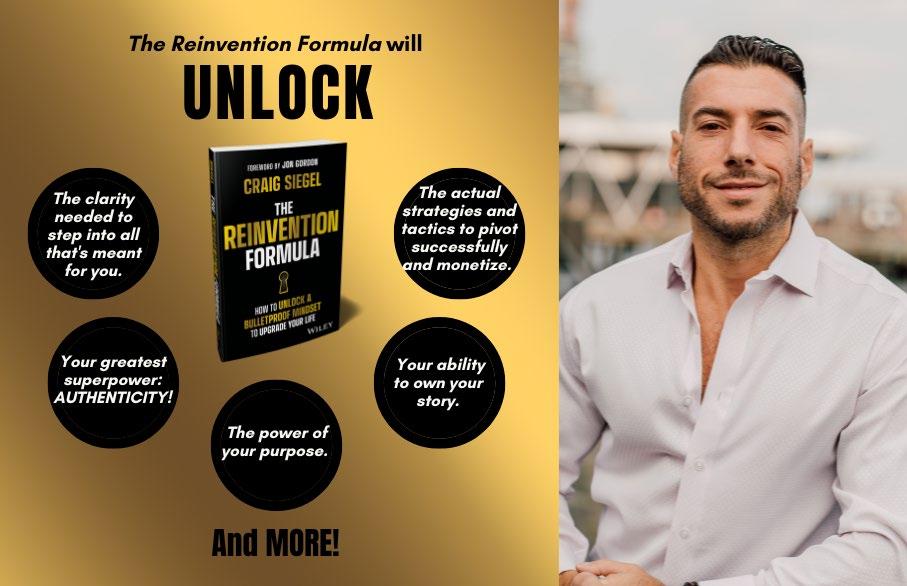
Dennis: What is “The Reinvention Formula” and how does it work?
Craig Siegel: Prior to the pandemic, I spent thirteen years working on Wall Street. I made money and at the time believed that was all that encompassed success. While money is part of success, it’s not the whole thing.
A few years ago, I went through a series of
challenges. I got out of a toxic relationship and my father was diagnosed with cancer, which he’s still battling. At that time, I also had my own business and although I was making money, I wasn’t putting a dent in the universe.
On Mondays, I looked forward to the weekend. I was trying to escape. I drank more than I’d like to admit.
13
I’m not sure if running found me or if I found running. I wasn’t a runner, you couldn’t pay me to run, but all of a sudden, I started signing up for marathons. Running helped me cultivate confidence and grit. It helped me find myself when I was looking for purpose.
When the pandemic hit, I looked at it as a historic opportunity. When is the world ever going to sit still like this again?
I made myself available. I quieted down. I blocked out external noise and interference. I connected with myself.
For fifteen years, I have studied personal development: mind programming, mindset, the law of attraction, emotional intelligence and more. It’s more than a passion for me—it’s my calling.
My CLS brand, Cultivate Lasting Symphony, came to me one day. I got home from work and put together this whole vision. There is a difference between a dream and a vision. Everyone has dreams, and unfortunately most people don’t reach
them. Visions are tangible. They’re plans.
My vision was of a tenlane highway, each lane representing something different: speaking, coaching, podcasts, book deals, TED talks, and so on. I reverse engineered this highway in my head. “What do I have to do now?” I asked myself.
I built a personal brand from the ground up. I had no following and no connections.
At one point, I wondered if I could really do it. People call that impostor syndrome, but I don’t like the word syndrome. I don’t want to give it power. Instead, I call it COI, or cost of inaction.
The COI was way too high for me, so I took action. For the first time in my life I was in alignment.
In the last two and a half years, the CLS brand has exploded. I have spoken all over the world, have had book deals, run a huge podcast sponsored by Mark Cuban, and much more.
life. I am engaged, and we recently added a puppy to the family. I pivoted into success in such a short amount of time that it shocks people.
That’s the Reinvention Formula. It’s everything I know to be true today, all of the personal development I’ve studied for fifteen years.
Dennis: How did you find the power to pivot?
Craig: A whole mindset shift.
I came up with the formula and realized I didn’t know what steps to take next, because I knew I was meant for more. We all are. We’re all here for something big. I think it’s our purpose to identify our calling, make an impact, contribute and unapologetically make money.
I made two lists—and I encourage readers to do the same.
One list contained everything I love and feel passionate about. You can start with ten things.
I sold my Wall Street business and reinvented not only my career, but my
On the other side of the paper, I wrote a list of ten skills I excel at—my
14
superpowers, or gifts, if you will.
Effective communication is one of my skills, and one of my loves is personal development, so I married those together.
I don’t want to be the next Tony Robbins. I want to be the first Craig Siegel.
By writing all of that down, I gave myself direction. I felt energetic and alive.
Dennis: What is the next step in the CLS reinvention formula?
Craig: The three Rs: Redesign Reenergize Reinvent
Redesign your mindset. Many people feel stuck because they are so invested in the story of their own life, that this is it for them.
I thought I was a Wall Street guy, that I’d always be stressed out and make a certain amount of money, that falling in love and having abundance weren’t in the cards for me.
the pandemic, it occurred to me that I had a choice. We all do. It’s time to invest in a different story, one where instead of thinking about everything that can go wrong, you think about what can go right.
I leaned into that, removed disempowering thoughts holding me back, and replaced them with empowering thoughts to propel and encourage me.
Thoughts are random, but thinking is not.
It’s fine to have negative thoughts, but consider that you can choose to focus on positive, empowering thoughts instead.
Reenergizing is the next step. People ask me, “What are you on?” I’m like, “You don’t get it. It took me thirty-five years to find alignment. I love what I do—that’s the key.” That’s what I want for everyone.
Dennis: Was your mindset typically negative during your Wall Street career? Did you start feeling empowered after you felt aligned with yourself?
Craig: It’s interesting, because I was actually a positive thinker, having studied personal development for years. That was a key piece in helping me find what I loved.
But I was a gladiator in the wrong arena. When you’re out of alignment for long enough, you fall into jadedness and negativity. I had a victim mentality, and I let myself get beaten down by life.
Everyone experiences that to some extent, but you have to realize that you have a choice.
My life started taking off when I combined my passion with my purpose.
When I got quiet during
Reinventing your identity is the final step. During my journey, I started showing up for the world as a real, authentic, weird me—for the first time in my life— and once I started doing that, the world took notice.
Dennis: Do the people you surround yourself with impact your mindset? Are they supportive?
Craig: When I started doubling down on
15
building a community, it changed everything for me.
I thought, “Let’s say I become amazing at what I’m doing. If nobody receives it, what is it good for?”
While I built the brand, I built the community simultaneously. I built up the CLS membership afterward.
There is a huge difference between an audience and a community. An audience is metrics. It’s vain. People have fake followers and the numbers mean nothing.
A community has personal connections. You interact and go the extra mile with people in your community. During the lockdown, I stayed up late into the night responding to comments and messages from people online. That made all the difference in the world to people consuming my content.
Dennis: How did you walk away from your career and start a business?
Craig: You have to make it real for yourself.
I did this eulogy exercise, where I said, “This is it for me. In two weeks, people will gather at my funeral. Who will show up? What will they say? What is my legacy? What did I contribute and what impact did I make?”
I was underwhelmed by the feedback I gave myself. I was underachieving.
Many people fail because they’re too scared to try. The COI—cost of inaction—was so high for me that I associated death with choosing to go back to lockdown and be miserable.
Suddenly, my fear of stepping into the unknown transformed into excitement because I had my worst-case scenario.
What is the cost of not taking action? My biggest fear is regret.
For the last two and a half years, I’ve given life everything I have, and it’s probably not a coincidence that I’ve seen great success.
for the second or third time in a different season of life and take a deeper meaning from it.
I read The Secret by Rhonda Byrne several years ago, and though I liked it, I didn’t think about it much the first time I read it.
During the pandemic, when I was building CLS, I reread the book. This time, I was available. It was like a portal to expansion. I applied it to my life and finally understood how to manifest. Everything came together.
Lastly, you have to marry the process and divorce the outcome of what you’re doing. Set your intentions. Put up a whiteboard and write down your audacious goals. Be bold, and then divorce from your goals. Ask, “What can I do today to get a little further?”
Additionally, you have to be available. You can read a book or watch a movie
You don’t have to get the touchdown on the sevenfigure deals every day, but if you show up daily, you can get a first down. You can move the chains and get further ahead. It compounds. Fall in love with the journey.
16
Dennis: Did you reverse engineer the process when you put all your goals together?
Craig: Yes. I cultivated it somewhere along the lines of my personal development journey. It’s important to reverse engineer your big goals. You have Z, which is great, but now you need to figure out how to go from A to B.
If you wanted to start a big podcast to make a lot of impact, how do you get there? You might have 300 followers on Instagram. It occurred to me that I would have to build a personal brand, get exposure, and extend my reach by building a frequency, a vibe, for others to see. That’s a powerful tool for anybody with goals: set the vision, the intentions, and then work backward.
Dennis: What advice would you give people who are building a brand?
Craig: Be selective and intentional with the frequency you give off. I am choosy about who I associate and collaborate with on my podcast. I wanted big names and
intriguing conversations, and I knew that doing a good job would lead to more eyes on my content.
Think big and be intentional. How do you want it to be perceived?
Authenticity and vulnerability make all the difference for personal brands. Don’t be afraid to stand out. Be yourself. It doesn’t matter if you’re weird. Stand for something. Show what’s going on behind the scenes. Share your challenges and setbacks. It makes for a stronger, more relatable community.
I’m a recovered people pleaser. I used to be inauthentic. I wanted to fit in, so I showed off what I thought the world wanted to see.
I made myself one promise when I started CLS: no matter what happens, I’ll be me. If it didn’t work, even though I thought it would, at least I would have failed being myself.
Dennis: How do you deal with negativity?
Craig: I’m not everyone’s cup of tea or glass of whiskey. I’m strange and weird. I don’t want to be
for everybody. The more authentic I am, the more the right people will gravitate to me, and then life will create a filter and the wrong people will go away.
This is cliche, but what others think of me is none of my business. All I can do is give my best every day and encourage those around me.
Dennis: What was it like running your first marathon?
Craig: It was a huge step forward for me. I had never been a runner. When I signed up, I only had six months to train for the marathon, and it was over 26 miles long. It was one of the most exhilarating experiences ever. I couldn’t tie experience to confidence.
I learned so much about myself. I had to battle the voice in my head, so to speak, by lowering it when it got negative.
After the marathon, I had a new point of reference. If I can run a marathon, I can do new things in other areas of my life, too, even if they’re hard or unfamiliar to me.
17
In my upcoming book “The Reinvention Formula,” I go into detail on how I felt disappointed and angry, because I had a goal to complete the marathon in under four hours, and I didn’t accomplish that.
That led to an obsession. I ran four marathons that year. Recently, I broke my personal record and completed a marathon in three and a half hours.
When you defeat the voice in your head, you’re stronger and better for it.
Dennis: What does your training regimen look like?
Craig: I signed up for the New York City Marathon coming up in November. I’m going crazy right now with CLS, my fiancée, our new puppy, and life in general, so my fitness routine—though I work out every single day—has fallen by the wayside a bit. Now, I have to reverse engineer a training plan for this marathon.
I like to give myself three months to train, because if it’s longer than that I get burned out. Pounding pavement is hard work.
Speed workouts, long runs on Sunday mornings, all of these training exercises are like a full-time job, but it’s a big part of my life. You need an outlet, whether it’s a sport or painting— anything that gets you thinking—separate from your career you can tap into and generate some confidence.
I’m looking to break my personal record every time I sign up for a marathon. My nutrition wasn’t on point for my last record break, and during the last marathon I did, I struggled for the last ten miles. I know I can do better.
Dennis: What do you see happening with your book, “The Reinvention Formula”?
can do anything you want to do.
I have read my fair share of self-help books and I wanted to create something different. “The Reinvention Formula” is more of a hybrid between being an official introduction of CLS to the world combined with my fifteen years’ worth of knowledge on personal development all in one.
This book isn’t niche. It’s not just for entrepreneurs, single moms, or construction workers. It’s for anybody looking to reinvent themselves in some area of life.
We’re excited for the August 15 launch. You can purchase it at Barnes & Noble, Amazon, anywhere you buy your books.
Going to sleep earlier, waking up earlier, cutting out the booze and eating better are all important pieces of a good training regimen.
Craig: We have a private launch team group for everyone who preorders it. We have bonuses, like an exclusive virtual event.
I want this book to help people think bigger, play bigger, and pivot toward success in their lives. You
If you preorder it, go to https://www. thereinventionformula. com/preorder and fill in your confirmation number to join the launch team. There will be giveaways, bonuses, signed copies and more.
Dennis: What battles have you faced since you reinvented yourself?
Craig: I know how it feels
18
to be certain that you’re here for much more than you’re settling for. I learned how to lean into that, to find clarity, and to pivot.
One thing I always say is it doesn’t take time, it takes alignment. It took me thirty-five years to find alignment, but when I did, everything started flowing, and now I’m available and I’m a vibrational match.
I feel very blessed, but there have been setbacks as well.
A few years ago, I got injured while playing football on the beach— which is never a good idea—and it turned out I had a tumor in my foot.
It was surgically removed and, thank God, it was benign. A month later, I ran the New York City marathon with no training. Last summer, I was crossing a street and got hit by a car. They sped off and blew through two red lights. Couldn’t believe it. I was shaken up, but thankfully unscathed. It wasn’t a coincidence—I’m here to do more work.
You can have it all: the relationship, the career, the wealth, the fun, if you find alignment.

Though I still have my challenges, I’m on the right path, and it feels
great. Let’s all do life together, win big, have fun, contribute and make an impact.
Find out more about Craig Siegel on Instagram, @ CraigSiegel_CLS. Watch his show, “The Paradigm Shift,” with David Meltzer live on Instagram every Saturday at 10:30 a.m. Eastern. His awardwinning podcast The CLS Experience is available on all podcast platforms.
Craig Siegel can be texted at (917) 634-3796 if you need some inspiration in your life (and make sure to include DENNIS in your text).


Agile Marketing: A Framework for Delivering Customer Value in a Rapidly

Changing Environment
21
These days, it’s all about keeping up with the ever-changing business landscape if you want your company to thrive. Being able to quickly adjust and navigate new challenges is key to staying ahead of the competition.
In other words, it’s all about being agile and adaptable! Customer needs and market conditions can change rapidly, and businesses that fail to adjust risk falling behind. This is where agile marketing comes in.
Agile marketing is a methodology that helps businesses deliver value to customers in a dynamic marketplace. The concept of Agile marketing originated from the software development industry and has since gained popularity across various sectors.
It’s a flexible framework that allows businesses to respond to changes in customer preferences and market conditions and an approach that emphasizes collaboration, experimentation, and iterative development.
Unlike traditional marketing, which follows a linear process, agile
marketing prioritizes continuous improvement and customer feedback. By promoting crossfunctional teams and data-driven decision making, businesses can meet customer needs and achieve marketing goals more effectively. As more businesses embrace digital marketing channels, agility and the ability to shift becomes more important. In an everchanging environment, businesses must be ready to respond to changing trends and algorithms online. That’s where agile marketing comes in.
Instead of planning huge projects with long timelines, you work in small, cross-functional teams to develop and execute marketing campaigns in short sprints. If you want to stay ahead of the game in the digital world, this method is an absolute powerhouse! It’s highly effective and efficient in getting things done, giving you a real edge.
The Benefits of Agile Marketing
Agile marketing is a game changer! It empowers you to respond rapidly to the
dynamic market and the ever-changing demands of your customers. With a nimble approach, you’ll always be ahead of the curve by adapting to the latest trends and innovations. Plus, you’ll keep your brand fresh, relevant, and in sync with your audience’s needs and preferences.
With this approach, you can stay one step ahead of the competition and meet your customers’ needs. It’s about being proactive and anticipating what they want before they even ask for it. Agile marketing empowers you to exceed your customers’ expectations, as opposed to traditional marketing campaigns that take forever to plan and execute.
It can be frustrating to keep up with a changing market. That’s where Agile methodologies make life easier. With this approach, marketers can try various tactics and tweak strategies according to what resonates with an audience. It’s all about finding what works best and staying ahead of the game! It’s a continuous process that helps optimize marketing strategies, leading to stronger
22
engagement and a higher return on investment.
Moreover, the Agile approach fosters collaboration and communication within the marketing team, leading to greater efficiency and stronger teamwork. Agile marketing provides a competitive advantage in today’s fast-paced and ever-changing business world.
Agile marketing is a modern approach that has gained widespread popularity because it prioritizes customer value. Unlike traditional marketing methods that focus on pushing products and services to customers, agile marketing focuses on meeting the specific needs and preferences of the target audience. This approach allows marketers to create campaigns tailored to the customer’s requirements, improving the customer experience.
Agile Marketing: A Framework for Delivering Customer Value in a Rapidly Changing Environment
By prioritizing customer value, Agile marketing allows companies to build strong relationships
with customers. This is because customers tend to gravitate towards brands that understand their needs and offer solutions that meet those specific requirements.
Agile marketing is a way to stay flexible and Adapt to changing customer demands and market trends. It allows marketers to adjust campaigns on the fly to ensure they continue to deliver value to customers - and that’s what it’s all about!
By keeping customer needs at the forefront, Agile marketing has become a powerful tool for businesses looking to build strong, loyal customer relationships. So, how does Agile marketing work in practice? Now, let’s explore the key components of an Agile marketing framework:
• Cross-functional teams: With Agile marketing, employees work in small, cross-functional teams that include representatives from different departments, such as design, development, and analytics. This enhances collaboration and alignment across different areas of the business.
• Sprints: Agile marketing campaigns are executed in short iterations, or sprints, that typically last two to four weeks. Throughout each sprint, the team puts all their energy into creating and carrying out exciting marketing initiatives, ranging from engaging social media campaigns to impactful email marketing and fascinating content creation.
• Continuous improvement: At the end of each sprint, the team evaluates the results of their marketing activities and adjusts based on customer feedback, market trends, and other factors. This allows continuous improvement and optimization of marketing campaigns over time.
• Data-driven decision making: Agile marketing relies heavily on data to inform decisionmaking. Marketers use analytics tools to track the performance of their campaigns, identify areas for improvement, and make data-driven decisions about future marketing activities.
23
The Challenges of Agile Marketing
One of the biggest obstacles to implementing an agile marketing approach is that it requires workplace cultural change. This shift requires a move away from traditional, hierarchical structures and towards more collaborative, cross-functional teams. This can be a daunting process, particularly for organizations that have been operating in a traditional way for many years. However, the benefits of Agile marketing make this approach a winner, despite these initial challenges.
It’s a modern approach that requires high levels of effective communication and collaboration between different departments. This is because Agile marketing is based on breaking down silos and working as cross-functional teams to achieve common goals. Its success stems from the ability to communicate and collaborate effectively across different teams and departments. Yet this can be a challenge, especially in large organizations where different departments may have different priorities and goals.
Despite these challenges, Agile marketing has become increasingly popular in recent years, particularly among startups and small businesses. The flexibility and responsiveness of Agile marketing make it an ideal framework for businesses operating in rapidly changing markets.
In a nutshell, embracing an Agile marketing approach can be a game changer for organizations, bringing many benefits. It not only allows quicker response to shifts in the market but also enhances customer engagement and increases the ability to adapt to changing scenarios.
Agile methodology is not just a buzzword, it’s a philosophy businesses can embrace to foster a culture of continuous improvement, collaboration, and experimentation. When businesses focus on providing greater value to their consumers, they not

only meet their customers’ requirements but also acquire a competitive advantage. It’s a win-win situation that results in satisfied clients and a successful business. So, don’t fall behindprioritize your customers’ needs and stay ahead of the game! In short, Agile methodology is about working smarter, not harder! With the pace of change accelerating in the modern business landscape, organizations that embrace Agile marketing are better positioned to thrive and succeed in the long term.
So, don’t fall behindprioritize your customers’ needs and stay ahead of the game! In short, Agile methodology is about working smarter, not harder! With the pace of change accelerating in the modern business landscape, organizations that embrace Agile marketing are better positioned to thrive and succeed in the long term.
24


Improve Email Marketing Results Using the Six Cs of Content Clarity
Clear messaging is essential to stand out among countless marketing emails competing for consumers’ attention. According to a recent report, clear email marketing messages have a 17 percent higher click-through rate than confusing ones.

This is where the six Cs of clarity come in, which stand for comprehensible, consistent, coherent, compelling, customized, and credible. By being
clear in all six areas of communication, you can create more engaging messages that lead to better results for your email campaigns.
This guide looks more closely at the meaning and importance of the six Cs and shows how to incorporate them into your email messages. Keep it handy as a blueprint for campaigns to improve engagement and strengthen customer loyalty.
The six Cs of clarity are:
1. Comprehensible: Clarity of Purpose and Message
Definition of comprehensible: able to be understood.
Clarifying the purpose of each email enables you to focus on your main objective and tailor your copy accordingly, which helps ensure that your messages are easily understood. It also makes them more memorable,
26
which increases the likelihood that readers will respond emotionally and take action.
Tips to make your emails more comprehensible:
• Know exactly what you want to communicate before creating any email: Are you selling something, promoting an event, or sharing info? Be crystal clear.
• What do you want readers to do after reading your email? Keep in mind the end goal.
• Keep subject lines short, concise, and laser-focused on the content of the email.
• Draw readers in by starting with a headline that packs a punch and amplifies your message.
• Make sure the copy is centered around your main goal, and discard any irrelevant or surplus information.
• Make it easy to understand with straightforward, jargonfree language.
2. Consistent: Clarity of Tone of Voice and Brand Identity
Definition of consistent: always behaving or
happening in a similar, especially positive, way.
A consistent tone of voice makes your content recognizable, reinforces your brand identity, and helps build trust with your audience. It also gives customers a consistent experience wherever they encounter your content. Using a consistent tone creates a professional image, helps you stand out, and also makes you sound more authentic, which can strengthen customer loyalty.
Tips to make your emails more consistent:
• Use the same email template, sender name, email address, colors, and fonts.
• Create a style guide outlining your company’s values and personality. Make sure all team members stick to it.
• Keep your email frequency consistent to avoid overwhelming your audience.
• Use the same email signature for all emails.
• Proofread and edit your emails to ensure consistency in grammar and formatting.
3. Coherent: Clarity of Formatting and Design
Definition of coherent: logically or aesthetically ordered.
Disorganized email content can confuse and disengage readers, causing important information to be missed. When the body of your email follows a logical order, it helps readers easily comprehend your message and improves its persuasiveness. A visually appealing email is also more likely to capture the reader’s attention and keep them engaged.
Tips to make your emails more coherent:
• To make reading easier, use sans-serif fonts such as Arial, Helvetica, or Verdana.
• Keep the font size between 12 to 14 points, with headings slightly larger.
• Use bold and italics sparingly to emphasize key information.
• Avoid long paragraphs and use subheadings for easier navigation.
• Use bullet points or numbered lists to highlight important information.
27
• Include plenty of white space to make emails visually appealing.
• Use a consistent color scheme.
• Make sure images or graphics are relevant and high quality.
• Use left-aligned text.
4. Compelling: Clarity of Call to Action and Benefits
Definition of compelling: strongly or irresistibly evoking interest or attention.
When reading an email, people typically look for the benefits that the email will bring them. If your call to action is unclear or buried within the email, you risk losing the recipient’s attention and missing out on potential conversions. Crucially, you need to make it clear how readers will benefit from taking further action.
Tips to make your emails more compelling:
• Use language that speaks directly to the reader’s pain points.
• In any call to action, use active language and strong action verbs. For example, “Claim your discount now” is better than “Find out about
the discount here.”
• Place the call to action above the fold and also at the end.
• Use bold or contrasting colors to make the call to action stand out.
• Use specific language highlighting the key benefits that readers will gain from taking further action.
• Highlight what makes you different from competitors.
• Focus on how readers will benefit from your product or service instead of just highlighting its features.
• Insert customer testimonials to provide social proof.
• For offers, provide a deadline or expiration date to create a sense of urgency.
individual needs. Find out what your readers really care about through customer service feedback and social listening.
You can then create more customized content that directly addresses their interests and helps them overcome challenges.
Tips to make your emails more customized:
• Use email surveys to get to know your audience’s preferences, interests, and pain points.
• Segment your list based on demographic and behavioral data.
• Send offers based on the recipient’s past purchases or interests.
5.
Customized: Clarity of Target Audience
Definition of customized: made or fitted to the needs or preferences of a specific customer. Take the time to understand your audience. According to a Salesforce report, 66 percent of consumers expect brands to understand their
• Use triggered emails based on the recipient’s behavior, such as abandoned cart emails or re-engagement emails.
• Use segmentation to create specific campaigns for different types of customers, such as frequent purchasers or new subscribers.
• Personalize subject lines with the recipient’s name.
6. Credible: Clarity of Sender
Definition of credible: able to be believed or trusted. A consistent sender name and email address are key to building and maintaining customer trust. Suspicious or unclear sender information can make the email look like spam.
Tips to make your emails more credible:
• Use an email address that includes your business’s domain name.
• Avoid using overly complex sender names or email addresses.
• Include a recognizable logo in the email signature to reinforce your business’s identity.
• Include your phone number and physical address to show that you’re a real business and are willing to be contacted.
• Include links to your social media channels.
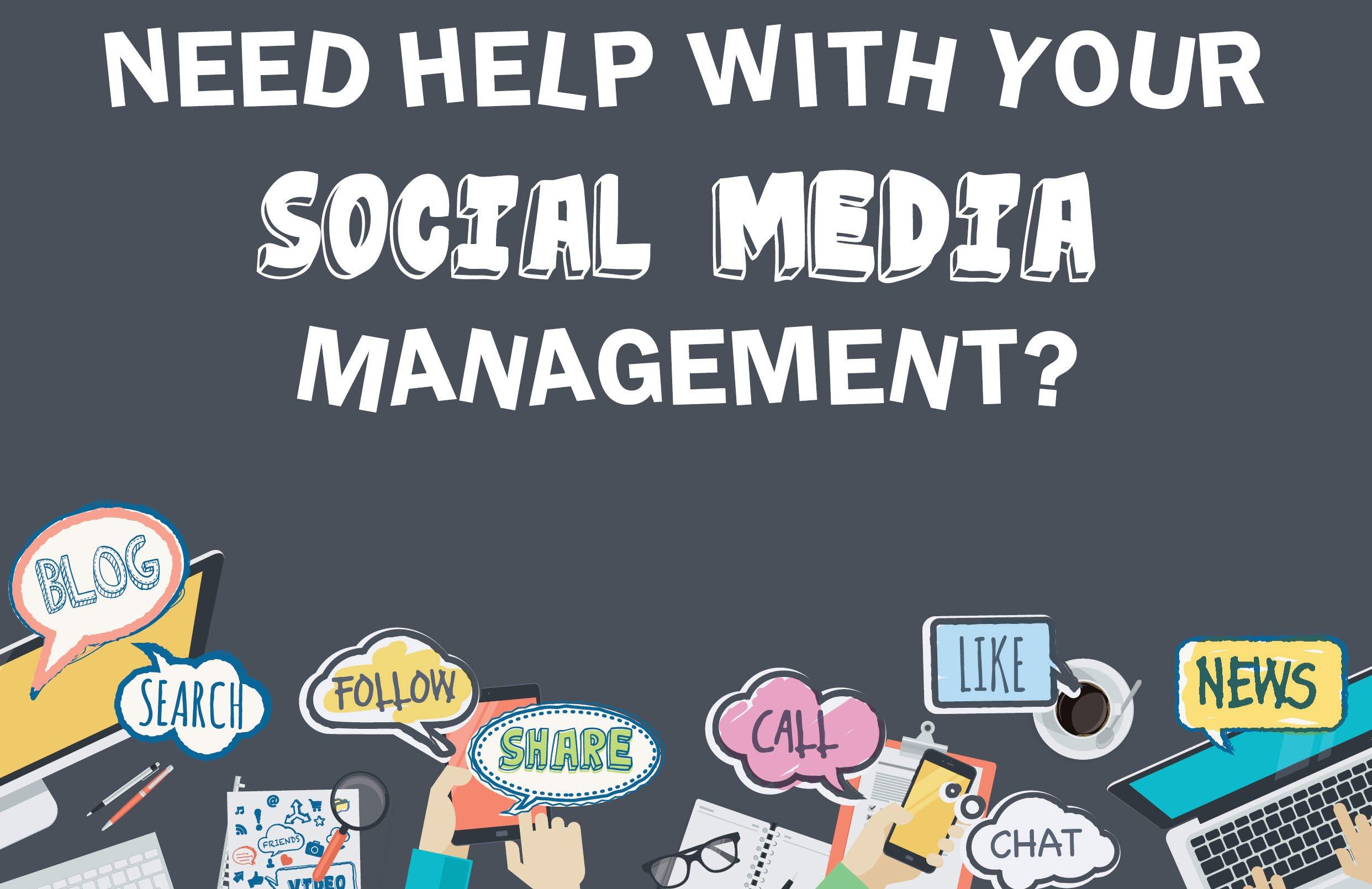
• Provide users with a clear “unsubscribe” link.
Unlocking the Power of Clarity in Email Communication
Incorporating the six Cs of clarity into your email marketing strategy can make a world of difference in the effectiveness of your messages. By remembering these key principles, you can improve your open rates, click-through rates, and, ultimately, conversions. So, next time you’re preparing an email campaign, use the six Cs to shape your content and improve the clarity and power of your messages.
Contact Us Today! (800) 277-7398
August was named in honor of Augustus Caesar. It has 31 days because Augustus wanted as many days as Julius Caesar’s month of July had. They took that extra day from February.

Fans of Elvis Presley mourn each Aug. 16th, the day the famed singer died in 1977
August Milestones:
• August 1st, 1981 - MTV network debuted on cable television, actually playing music videos 24 hours a day. The Buggles’ “Video Killed the Radio Star” was the first video shown

• August 5th, 1957 - American Bandstand debuted on the ABC television network, with host Dick Clark.
• August 6th, 2012 - NASA’s Curiosity rover landed on the surface of Mars
• August 12th, 1981 - The IBM Personal Computer was released.
• August 16th, 1954 - The first issue of Sports Illustrated was published
• August 21st, 1911 - The Mona Lisa was stolen by a Louvre employee, Vincenzo Peruggia. It was returned in 1913
• August 30th, 1984 - The Space Shuttle Discovery took off on its maiden voyage
30
Email Marketing in 2023

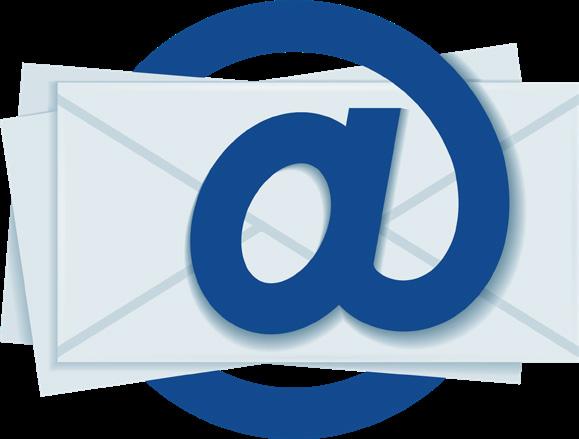
347.3 billion emails are exchanged daily worldwide.

There are 4.37 billion daily email users globally as of 2023.
The number of daily email users is set to reach 4.6 billion by 2025.
36.6% of emails globally are opened via mobile devices
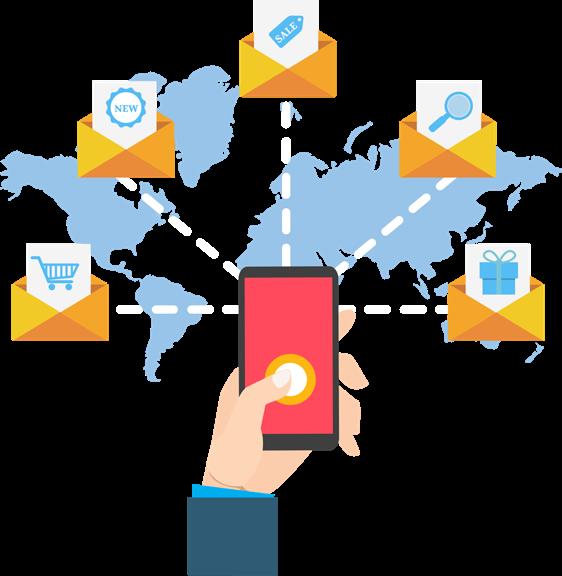

The average email open rate for welcome emails is 68.6%
49% of consumers said that they would like to receive promotional emails from their favorite brands on a weekly basis
The average expected ROI is $36 for every $1 you spend
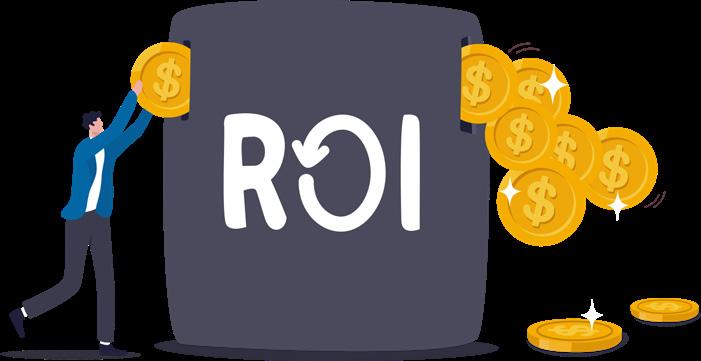
Adding videos to your email can increase click rates by 300%


Emails with personalized subject lines generate 50% higher open rates
Sending three abandoned cart emails result in 69% more orders than a single email.
More than 90% of businesses say email marketing is important to their company’s overall success.
Email is considered one of the most effective channels for marketing, with 79% of marketers placing it in their top 3.




































